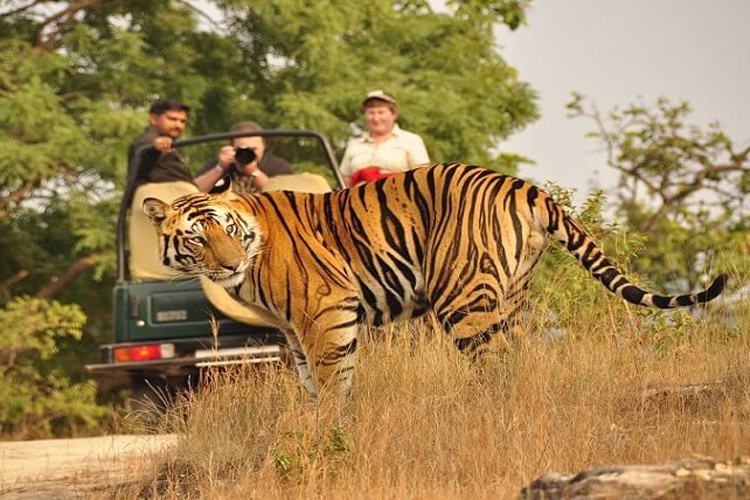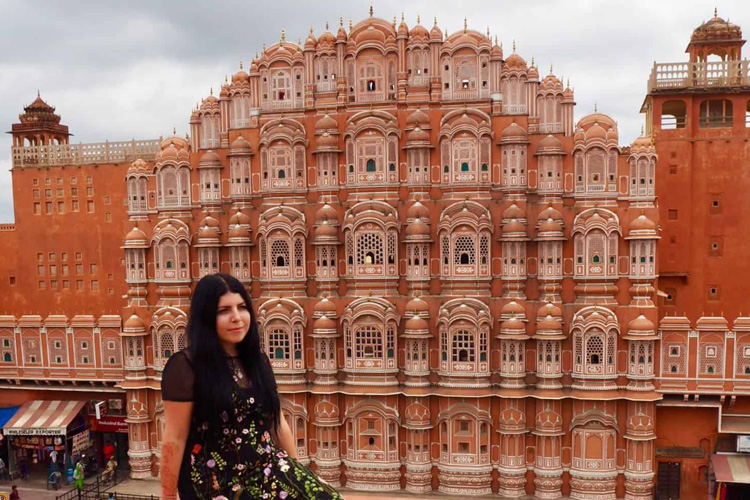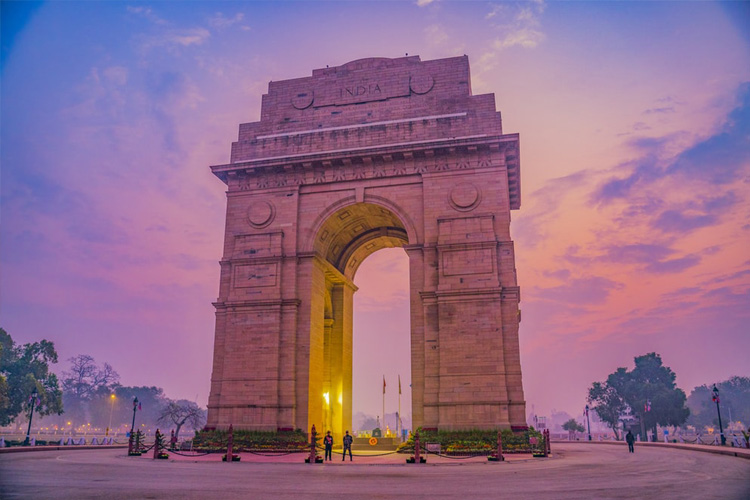




One of the most well-liked tour packages for visiting North India is the Golden Triangle tour with Jim Corbett National Park wildlife and lasts for 8 nights and 9 days, it is ideal for learning about the history, customs, and wildlife of North India. Travelers who love history will discover their adventurous side with this exclusive travel package. The Golden Triangle is the triangle formed by the three most important historical sites in India: Delhi, Jaipur, and Agra. These three cities are the most popular travel destinations in India since they are the gold mines of ancient Indian history, culture, and customs. You will have the opportunity to investigate the numerous ruins of historic buildings such as temples, majestic palaces, powerful forts, and ancient monuments.
By including the thrilling forest safari of the Corbett National Park into your historical tour of the Golden Triangle, one of India’s most well-known tiger reserves, the Corbett Wildlife Tour and the Golden Triangle Tour will keep your adventure novel. The best place to witness majestic tigers in their natural habitat is the Corbett National Park. The capital city of India, Delhi, is the ideal place to begin your journey because it perfectly combines old and modern architectural wonders. From there, you will explore the history, culture, and traditions of Jaipur and Agra as well as the world-famous Taj Mahal. Finally, before returning to Delhi, you will have the opportunity to see the Forest of Jim Corbett which is the home of the Bengal Tigers.
Arrive by International flight, after that we would assist you at Airport and transfer to hotel for check in.
Delhi is a thriving city that successfully blends the ancient and the modern; its advantageous position was a major factor in the choice of the city as the seat of successive rulers. Several mythological cities, including the city of Indraprastha from the Hindu epic Mahabharata, are thought to exist here. Over the course of several centuries, numerous monuments were built by various rulers, including Qutub-Ud-Din, Alauddin Khilji, Tughlaq, Humayun, and Shahjahan, who constructed the walled city of Shahjahanabad. Later in first half of 20th Century part of New Delhi was built by Sir Edwin Lutyens who laid out a grandiose Central Administrative District as a testament to British control in India.
Overnight Hotel in Delhi
We embark on a guided tour of Old Delhi today, which is the 17th-century walled city of Shahjahanabad. We also visit the Great Jama Masjid, which is the principal mosque in Old Delhi and was constructed in 1656 A.D. by the Mughal ruler Shahjahan Khan. In India, this is the biggest and most well-known mosque. Later, we descend or ride in a rickshaw through Chandni Chowk, Shahjahanabad’s former marketplace that has been transformed into a charming bazaar. The Raj Ghat memorial in New Delhi honors Mahatma Gandhi, the father of the nation. It is a straightforward black marble platform that marks the location of his cremation on January 31, 1948.
Moving forward, we cross the India Gate Memorial, which was constructed in 1931 to honor Indian soldiers who lost their lives in World War I.
We then make a dry pass through President’s House, which was constructed in 1931 as the official residence of the President of India. Formerly called Viceroy’s House, it housed the Governor-General of British India until 1950.
You will see Humayun’s tomb, a memorial to the Mughal emperor Humayun constructed in 1562. This is the first example of Mughal architecture in India and a World Heritage Site.
Qutub Minar – Built in the year 1206 by Qutub -Ud – Din Aibak, it is the tallest 73 metres brick minaret in the World an important example of Indo – Islamic Architecture. Qutub Minar is listed as a UNESCO World Heritage site.
Overnight Delhi
Today we drive to Jaipur also referred to as the Pink City, the vibrant and colorful capital of Rajasthan, with a rich history filled with heroic and valiant tales. It is currently one of India’s most significant Heritage Cities. The Amerindian ruler, Maharaja Sawai Jai Singh II, built the city in 1728. It remains the sole City of the World symbolising the Nine division of the Universe through Nine rectangular sections.
• Chokhi Dhani (Optional) — An nighttime excursion to the Chokhi Dhani complex, an ethnic village resort 15 km far from Jaipur, including entertainment by musicians and folk dancers as well as a recreation of a Rajasthani village atmosphere on the expansive grounds. Drive back to the hotel afterwards.
Overnight Hotel in Jaipur
Start your morning exploring the beauty of Jaipur, Visit to Amer Fort, Jal Mahal, City Palace, Hawa Mahal and Jantar Mantar.
• Amer Fort – Explore the splendor of Amer Fort, a stunning monument that is a must-see. Amer Palace, an Old Fort overlooking Maota Lake and situated amid hills, is among the best specimens of Indo-Islamic architecture, having been constructed in 1592 by Maharaja Man Singh.
On the return from Amer Fort we will halt to view the Jal Mahal (Water Palace).
• Jal Mahal – Located in the center of Man Sagar Lake, Jal Mahal is a massive palace built of pink sandstone that adheres to the traditional and royal Rajputana symmetry.
• City Palace – This Palace was built on the orders of Maharaja Sawai Jai Singh second and it is Jaipur’s main attraction, reflecting a mix of Mughal and Rajput architectural styles.
• Hawa Mahal – Built by Maharaja Sawai Pratap Singh, this five-story structure is commonly referred to as the “Palace Of The Wind.” There are 953 windows in this palace, and each one is beautifully designed.
• Jantar Mantar –Given its historical significance, Jantar Mantar is home to the largest sundial in the world. Among the biggest observatories in the world is this one. Jantar Mantar is now a recognised World Heritage Site by UNESCO.
Overnight Jaipur
Following breakfast, we will leave for Agra at 9:00 a.m. and stop at Fatehpur Sikri, a masterpiece of sandstone with exquisitely elegant palaces. Akbar once called Fatehpur Sikri the capital of his Mughal Empire, but he abandoned it due to a shortage of water.
Magnificent sites here include the grave of Sufi saint Sheikh Salim Chishti, Buland Darwaza, the largest doorway in the world, and Jama Masjid.Continue on to Agra and check into the hotel there.
Overnight Agra
Today, we see the Taj Mahal, one of the Seven Wonders of the World and a representation of unending love. Constructed over the course of 22 years in 1631 by the fifth Mughal emperor Shahjahan, it stands on the banks of the Yamuna river.
We would next proceed to the Agra Fort, which was built of red sandstone that was frequently inlaid with white marble and elaborate ornamentation. The Fort was eventually taken over by the Mughals in the sixteenth century, replacing the Lodhi family.
Further we proceed to Delhi, upon arrival check in at Hotel.
Overnight Hotel in Delhi
Drive to Jim Corbett National Park, which is home to the animals named for the renowned British hunter turned conservationist, Jim Corbett, following an early breakfast. The atmosphere is full of fascinating tales and anecdotes about him and his experiences, It is tucked away in the Himalayan foothills and boasts a very diverse topography and vegetation, which contributes to the area’s rich biodiversity and scenic splendor.
The park is spread across approximately 920 square kilometers at an altitude of 600–1100 meters about the foothills of the Western Himalayas in the districts of Nainital and Pauri Garhwal. Corbett has a healthy population of tigers. Four species of deer, including Hog deer, Sambhar, Spotted deer, and Barking deer, as well as prey, such as wild boar, support the predators. In addition, the Tiger Corbett Biosphere Reserve is home to 25 types of reptiles, 580 different kinds of birds, and 50 mammal species. Elephants, a wide variety of avifauna, Himalayan Black Beer at the higher altitudes, and cats that resemble sloth bears are also found in the park.
Upon arrival check in the Hotel, Evening at leisure.
Overnight Jim Corbett
Prepare in the early hours of the day for your wildlife safari in the Corbett Tiger Reserve’s separate tourism zone. Return to the hotel for breakfast and lunch, then go on another safari in the Corbett area in the afternoon. At night, enjoy supper at the resort.
Overnight Jim Corbett
The final day will be spent relaxing with morning tea and getting ready to depart for Delhi. Once in Delhi, you will be sent off at the railway station or at the airport for your next destination.
Golden triangle tour with jim Corbett national park by car costs $ 400 plus including accommodation and breakfast in 5 star hotel.
Corbett National Park (wildlife) is situated in the foothills of the Sub- Himalayan belt in Nainital districts of Uttarakhand state in India, with headquarter stationed at Ramnagar.
Corbett Tiger Reserve (Wildlife) has five tourism zones for five exclusive tourism zones namely Bijrani, Jhirna, Durgadevi, Dhikala and Sitabani. The forest department has opened new tourism zone named Dhela.
Corbett Tiger Reserve (wildlife) remains open from 15th November to 30th June every year. Best time to visit Corbett is from November to mid May.
Corbett Tiger Reserve (wildlife) remains closed for the period from July to October as the monsoon season approaches during these periods. It is so because the roads inside the park get washed away due to rain.
Note: Jhirna, Dhela and Sitabani tourism zones remains open all thorughout the year for tourists.
180 vehicles are permitted to enter the park per day, including the morning and afternoon drives. Bijrani Zone accommodates 60 vehicles; Jhirna Zone accommodates 60 while Dhela & Durgadevi zones accommodate 15 vehicles per day.
Accommodation facilities are available inside the core area of the forest, Tourists can stay at designated forest lodge namely Dhikala, Jhirna, Sultan and Gairal forest rest house. Apart from these forest lodges several other luxury resorts are also available in the outskirts of Corbett, you may send query for the advance booking.
Our Destination expert will be happy to help you resolve your queries for this tour.
24/7 Support Available
WhatsApp us
